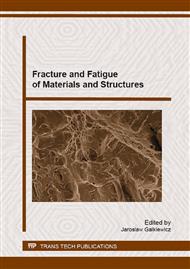[1]
Kluger K. Fatigue life estimation for 2017A-T4 and 6082-T6 aluminium alloys subjected to bending-torsion with mean stress. Int J Fatigue 2015; 80: 22–9.
DOI: 10.1016/j.ijfatigue.2015.05.005
Google Scholar
[2]
Kluger K, Pawliczek R. Influence of the irregularity coefficient of loading on calculated fatigue life. J Theor Appl Mech 2013; Vol. 51: 791–8.
Google Scholar
[3]
Karolczuk A, Nadot Y, Dragon A. Non-local stress gradient approach for multiaxial fatigue of defective material. Comput Mater Sci 2008; 44: 464–75.
DOI: 10.1016/j.commatsci.2008.04.005
Google Scholar
[4]
Gerber W. Bestimmung der zulossigne Spannungen in eisen Constructionen. ZBayer Arch Ing Ver 1974; Vol. 6.
Google Scholar
[5]
Findley WN. A theory for the effect of mean stress on fatigue of metals under combined torsion and axial load or bending. J Eng Ind 1959; Nov.: 301–6.
DOI: 10.1115/1.4008327
Google Scholar
[6]
Dang Van K, Cailletaud G, Flavenot JF, Le Douaron A, Lieurade HP. Criterion for high cycle fatigue failure under multiaxial loading. Mech Eng Publ Lond 1989: 459–78.
Google Scholar
[7]
Carpinteri A, Spagnoli A, Vantadori S, Bagni C. Structural integrity assessment of metallic components under multiaxial fatigue: the C-S criterion and its evolution. Fatigue Fract Eng Mater Struct 2013; 36: 870–83.
DOI: 10.1111/ffe.12037
Google Scholar
[8]
Smith KN, Watson P, Topper T. Stress-strain function for fatigue of metals. J Mater 1970; 5: 767–78.
Google Scholar
[9]
Szala G, Ligaj B. Dwuparametryczne charakterystyki zmęczeniowe stali konstrukcyjnych i ich eks-perymentalna weryfikacja. Zbiór Monogr Red J Szala Wydaw Nauk ITE (2011).
Google Scholar
[10]
Gasiak G, Pawliczek R. Application of an energetic model for fatigue life prediction of the construction steels under bending, torsion and synchronous bending and torsion. Int J Fatigue 2003; Vol. 25: 1339–46.
DOI: 10.1016/s0142-1123(03)00055-0
Google Scholar
[11]
Socie DF. Critical plane approaches for multiaxial fatigue damage assessment. Am Soc Test Mater 1993; ASTM STP 1191: 7–36.
DOI: 10.1520/stp24793s
Google Scholar
[12]
Karolczuk A, Kluger K. Analysis of the coefficient of normal stress effect in chosen multiaxial fatigue criteria. Theor Appl Fract Mech 2014; 73: 39–47.
DOI: 10.1016/j.tafmec.2014.07.015
Google Scholar
[13]
Pawliczek R. Influence of the mean load value in fatigue block loading on strains. Key Eng Mater 2014; Vol. 598: 195–200.
DOI: 10.4028/www.scientific.net/kem.598.195
Google Scholar
[14]
Socie DF. Multiaxial fatigue damage models. ASME J Engin Mat Techn 1987; 109: 292–8.
Google Scholar
[15]
Niesłony A, Łagoda T, Walat K, Kurek M. Multiaxial fatigue behaviour of AA6068 and AA2017A aluminium alloys under in-phase bending with torsion loading condition. Mater Werkst 2014; 45: 947–52.
DOI: 10.1002/mawe.201400214
Google Scholar
[16]
Gasiak G, Pawliczek R. Calculation of fatigue life of specimens made of 18G2A steel under bending and torsional loading with different stress ratios. Materials Engineering 2002; Vol. 9, No 4: 31-40.
Google Scholar


